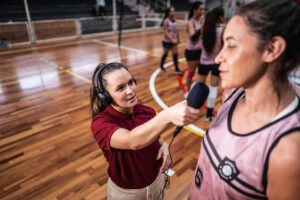What the DOT’s disability guidelines can teach us about accessibility comms
How do you help employees communicate with accessibility in mind?

As a communicator, one of the best ways to ensure your work effectively reaches its target is by learning from trends and patterns in the world around you.
This was the case last week when the United States Department of Transportation (DOT) recommended new guidelines for how airlines should accommodate passengers with disabilities. Its guidance should inspire you to consider not only how your accessibility communications reach employees, but how they communicate better with clients and customers.
Accountability and education
According to NPR, the Biden Administration proposed new standards for how airlines accommodate passengers’ disabilities. Under the proposed new rules, tentatively dubbed the Air Carrier Access Act, airlines would bear more responsibility when a traveler’s wheelchair is damaged or delayed in its return.
“People don’t realize that this is a part of my body. If this is broken, you’ve broken my legs,” said Illinois Senator Tammy Duckworth, who lost both of her legs in the Iraq war. Duckworth has pushed to require airlines to disclose how many wheelchairs they damage. She says they broke 892 wheelchairs in a single month last year.
“Imagine if the American public saw that the airlines broke 892 pairs of legs in a single month. There would be hue and cry, but there hasn’t been,” she said.
In addition, the proposed new regulations would mandate further training for air travel employees who handle wheelchairs and accessibility devices.
Regardless of physical ability, anyone has the right to travel by air. But the lesson you can learn as a comms pro centers on clarity in communication.
In a piece last year, we described how comms can help implement accessibility communications and serve as crucial advocates in making the workplace a better setting for everyone, regardless of ability. Johnson, a global co-lead of an employee resource group at PayPal, said that the process begins with education.
“When we were thinking of how we can employ more folks with disabilities, we thought, how can we educate people on these issues?” she explained. “Once you’ve gotten the education part down, it’s much easier to really get the ball rolling on wider changes that support accessibility and inclusion.”
Educating front-facing employees on accessibility comms
It’s easy to say that communicators need to maintain a focus on inclusion in their communication, but it’s another to make sure that process happens. Emphasizing clear communication and policies is a great place to start. The only way your employee base and your leaders are going to know how to best roll out accessibility comms is if you set them up for success by clearly explaining the guidelines and the process. Getting buy-in from both groups can be a major help in assuring the success of an accessibility communications campaign.
You can play a big part in getting your organization’s front-facing workers up to speed on new accessibility regulations and how to communicate mindfully with customers who have a disability. According to the ADA (Americans with Disabilities Act) National Network, some of the basic tips include:
- Speak directly to disabled individuals, not just their helpers. Don’t avoid eye contact.
- Staying ahead of accessibility features at your worksites or locations so you’re ready to answer questions and provide accurate information.
- Be patient with those who need more time to either communicate or move around.
- Ask questions and don’t assume anything about a disabled individual. Don’t pretend to understand what they mean to expedite the interactions.
- Keep a pen and paper on you for people who are deaf, hard of hearing, or have other disabilities that affect their communication and speech.
People with disabilities aren’t a monolith. Just as with any other group of people in the world, they come from many backgrounds and have different preferred methods of communication.
This proposed accessibility guidance is better than the airline industry, as it reminds us how we can approach our own accessibility comms. Educate, train, and ensure that everyone’s on the same page, and you’ll be in a great position for success.
Sean Devlin is an editor at Ragan Communications. In his spare time he enjoys Philly sports, a good pint and ’90s trivia night.







